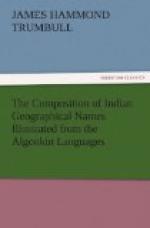I. Those formed by the union of two elements, which we will call adjectival and substantival;[3] with or without a locative suffix or post-position meaning ‘at,’ ‘in,’ ‘by,’ ‘near,’ &c.
[Footnote 3: These terms, though not strictly appropriate to Indian synthesis, are sufficiently explicit for the purposes of this paper. They are borrowed from the author of “Words and Places” (the Rev. Isaac Taylor), who has employed them (2d ed., p. 460) as equivalents of Foerstemann’s “Bestimmungswort” and “Grundwort,” (Die deutschen Ortsnamen. Nordhausen, 1863, pp. 26-107, 109-174). In Indian names, the “Bestimmungswort” sometimes corresponds to the English adjective—sometimes to a noun substantive—but is more generally an adverb.]
II. Those which have a single element, the substantival or ‘ground-word,’ with its locative suffix.
III. Those formed from verbs, as participials or verbal nouns, denoting a place where the action of the verb is performed. To this class belong, for example, such names as Mushauwomuk (Boston), ‘where there is going-by-boat,’ i.e., a ferry, or canoe-crossing. Most of these names, however, may be shown by rigid analysis to belong to one of the two preceding classes, which comprise at least nine-tenths of all Algonkin local names which have been preserved.
The examples I shall give of these three classes, will be taken from Algonkin languages; chiefly from the Massachusetts or Natick (which was substantially the same as that spoken by the Narragansetts and Connecticut Indians), the Abnaki, the Lenni-Lenape or Delaware, the Chippewa or Ojibway, and the Knisteno or Cree.[4]
[Footnote 4: It has not been thought advisable to attempt the reduction of words or names taken from different languages to a uniform orthography. When no authorities are named, it may be understood that the Massachusetts words are taken from Eliot’s translation of the Bible, or from his Indian Grammar; the Narragansett, from Roger Williams’s Indian Key, and his published letters; the Abnaki, from the Dictionary of Rale (Rasles), edited by Dr. Pickering; the Delaware, from Zeisberger’s Vocabulary and his Grammar; the Chippewa, from Schoolcraft (Sch.), Baraga’s Dictionary and Grammar (B.), and the Spelling Books published by the American Board of Commissioners of Foreign Missions; and the Cree, from Howse’s Grammar of that language.
The character [oo] (oo in ‘food;’ w in ‘Wabash,’ ’Wisconsin’), used by Eliot, has been substituted in Abnaki words for the Greek [Greek: ou ligature] of Rale and the Jesuit missionaries, and for the [Greek: omega] of Campanius. A small [n] placed above the line, shows that the vowel which it follows is nasal,—and replaces the n employed for the same purpose by Rale, and the short line or dash placed under a vowel, in Pickering’s alphabet.
In Eliot’s notation, oh usually represents the sound of o in order and in form,—that of broad a; but sometimes it stands for short o, as in not.]




